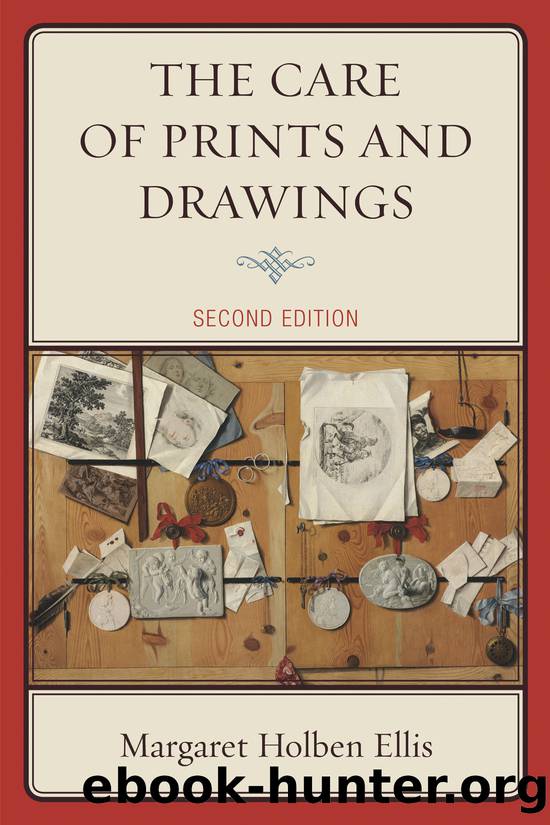The Care of Prints and Drawings by Ellis Margaret Holben;

Author:Ellis, Margaret Holben;
Language: eng
Format: epub
Publisher: Rowman & Littlefield Publishers, Incorporated
Chapter 6
Preventive Conservation for Prints and Drawings
In order to understand the pervasive role of conservation in museum operations, it is useful to be familiar with the range of institutional activities and the âbest practicesâ that govern them. The American Alliance of Museums (AAM) identifies five core documents as fundamental for demonstrating an institutional commitment to professional procedures:
⢠Mission Statement
⢠Institutional Code of Ethics
⢠Strategic Institutional Plan
⢠Collections Management Policy
⢠Disaster Preparedness and Emergency Response Plan
Conservation concerns â both philosophical and practical â are reflected in each one of these documents, for example, most Mission Statements clearly articulate the preservation of the collection as a primary goal. Likewise, the improvement of a storage facility might be part of a Strategic Institutional Plan or the number and distribution of disaster response carts specified in the Emergency Response Plan. In general, conservation procedures and policies are considered in greatest detail in the Collections Management Policy and the Disaster Preparedness and Emergency Response Plan.
The Collections Management Policy1
The Collections Management Policy is a written document approved by a ruling authority, usually the Board of Trustees or government entity that specifies the institutionâs policies concerning all collections-related issues including:
⢠Acquisitions/accessioning
⢠Deaccessioning/disposal of collections/use of proceeds from the sale of deaccessioned collections for âdirect careâ
⢠Loans, incoming and outgoing
⢠Collections care; risk assessment and management
⢠Inventories and/or documentation and tracking of collections
⢠Access to and/or use of collections
In general, a Collections Management Policy addresses the development, uses, and preservation of collection items; increasingly the economic and environmental sustainability of these programs is also considered. Once again, conservation concerns are reflected throughout the Policy. For example, preventive conservation standards need to be assured when lending or exhibiting works on paper; the proceeds from the sale of deaccessioned objects are designated for âdirect care,â2 and risk assessment informs the Collections Care Program. In sum, all actions impacting collection items are viewed through the lens of preventive conservation.
What is preventive conservation?
Preventive conservation is defined as
the mitigation of deterioration and damage to cultural property through the formulation and implementation of policies and procedures for the following: appropriate environmental conditions; handling and maintenance procedures for storage, exhibition, packing, transport, and use; integrated pest management; emergency preparedness and response; and reformatting/duplication. Preventive conservation is an ongoing process that continues throughout the life of cultural property, and does not end with interventive treatment.3
Many aspects of preventive conservation may not be at first obvious, for example, the importance of maintaining up-to-date insurance policies, accurate catalog records, reliable tracking systems, regular condition surveys, continued professional development for staff, or specific housekeeping or building maintenance procedures, such as weed control around building foundations. A proactive attitude of preventive conservation should be thoroughly integrated into every operation from human resources to gift shop personnel, but, in particular, it actively involves facility managers, curators, registrars, art handlers, security staff, exhibit designers, architects, maintenance workers, and conservators.
The goals of preventive conservation are:
⢠To extend the life of cultural property.
⢠To reduce the risk of catastrophic loss of cultural property.
⢠To defer, reduce, or eliminate the need for interventive treatment.
⢠To extend the effectiveness of interventive treatment.
Download
This site does not store any files on its server. We only index and link to content provided by other sites. Please contact the content providers to delete copyright contents if any and email us, we'll remove relevant links or contents immediately.
Kathy Andrews Collection by Kathy Andrews(11737)
The remains of the day by Kazuo Ishiguro(8832)
Paper Towns by Green John(5092)
Spare by Prince Harry The Duke of Sussex(5078)
Industrial Automation from Scratch: A hands-on guide to using sensors, actuators, PLCs, HMIs, and SCADA to automate industrial processes by Olushola Akande(5001)
The Body: A Guide for Occupants by Bill Bryson(4978)
Machine Learning at Scale with H2O by Gregory Keys | David Whiting(4199)
Be in a Treehouse by Pete Nelson(3955)
Never by Ken Follett(3800)
Harry Potter and the Goblet Of Fire by J.K. Rowling(3776)
Goodbye Paradise(3730)
Into Thin Air by Jon Krakauer(3315)
The Remains of the Day by Kazuo Ishiguro(3296)
The Cellar by Natasha Preston(3265)
The Genius of Japanese Carpentry by Azby Brown(3228)
Fairy Tale by Stephen King(3227)
120 Days of Sodom by Marquis de Sade(3185)
Drawing Shortcuts: Developing Quick Drawing Skills Using Today's Technology by Leggitt Jim(3001)
The Man Who Died Twice by Richard Osman(2998)
